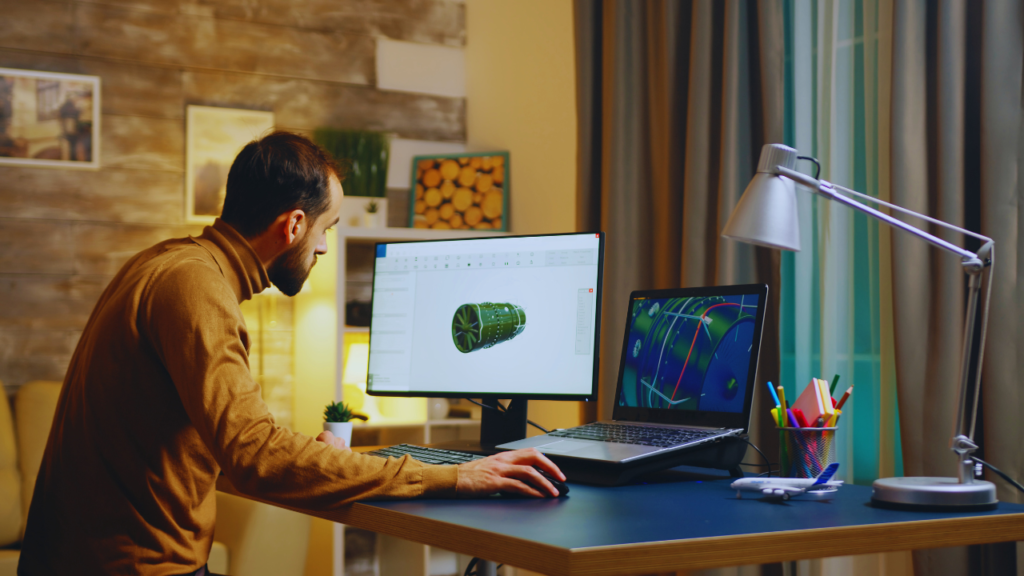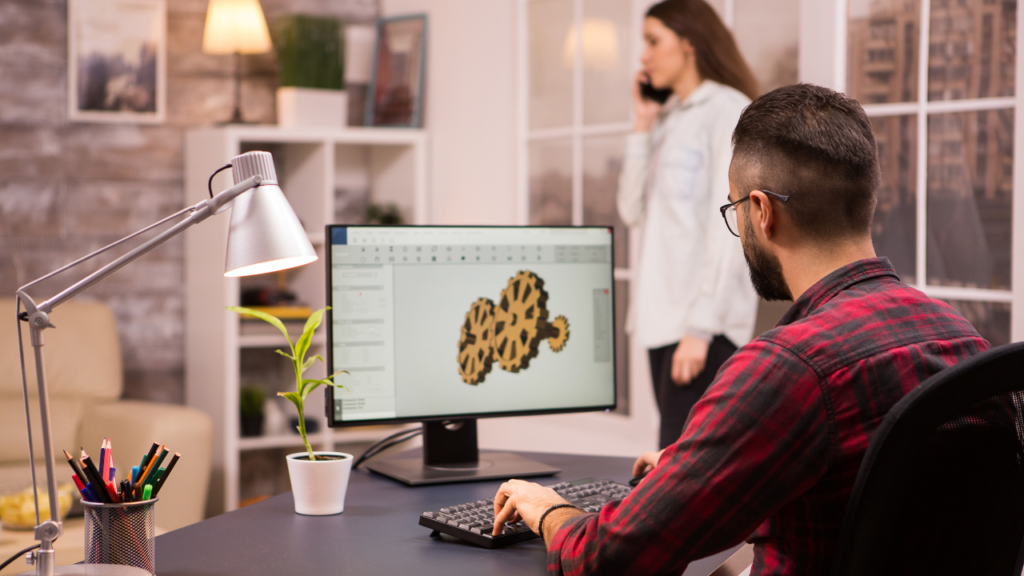What is CAD (Computer-Aided Design)? Shaping the Future, One Pixel at a Time
Sketch complex patterns on a napkin and imagine your work coming to life. Imagine, now, turning that napkin drawing into an accurate, computer-generated 3D model that is prepared for production. That is the wonder of Computer-Aided create (CAD), a technology that has completely changed the way we create of all sizes and Creative objects Including teacups and aircraft etc.

However, what is CAD exactly? To put it simply, it’s the virtual creation, modification, and analysis of designs using software. With CAD, you can utilize strong tools to sculpt complex 3D objects or draw 2D lines and forms instead of using pencils and paper. Consider it a digital workstation where you can precisely and pixel-by-pixel realize your ideas.
History of CAD
In 1960’s first computer software sketchpad was innovated by Lvan Sutherland, who is the backbone of Computer-Aided Design(CAD). The framework for what are now known as contemporary CAD systems was established by this unique program. The introduction of computer-aided drawing and design to worldwide by Sketchpad was a turning point in the history of design technology.
With the launch of sketchpad, Computer-Aided design(CAD) technology got Started the journey of continuous development. Mind-blowing advance in CAD system Over the years have changed the way design processes are carried out in various fields. In the discipline of design engineering, these developments brought in a new era of precision, efficiency, and originality by completely changing the way ideas are imagined, developed, and executed.
Evolution of CAD Software
The method by which Computer-Aided Design software is used has modified drastically over time. Very simple 2D drawing tools were used at first, which were rather basic. But as technology developed, CAD software additionally grew dramatically, opening the door for the complex 3D modeling worlds we see today. With their mind-blowing features and capabilities, these latest CAD system enables designers to create Complex and fabulous designed with ease. The design process has been completely transformed by the development of CAD, which has allowed experts to develop, revise and revisit the concepts with previously unheard-of efficiency and Precision.
Why is CAD so important?
Here are just a few reasons why CAD has become an essential tool in various industries:
| Benefit | Description | Example |
|---|---|---|
| Increased Efficiency | Automates repetitive tasks, frees up time for creativity and innovation. | Eliminates manual drafting and calculations, allowing designers to focus on conceptualizing and improving designs. |
| Enhanced Accuracy | Ensures precise measurements and eliminates manual errors. | Guarantees parts fit together seamlessly in final product, reducing costly rework. |
| Seamless Collaboration | Enables teams to work on designs simultaneously, regardless of location. | Streamlines communication and project execution, facilitates faster design completion. |
| Improved Communication | 3D models and simulations clearly communicate design intent. | Reduces misunderstandings between designers, engineers, and clients, ensures everyone is on the same page. |
| Faster Prototyping | Allows for virtual simulations, eliminating the need for physical prototypes. | Saves time and money, iterates design ideas quickly and efficiently. |
| Reduced Development Costs | Optimizes materials usage, identifies potential production problems early on. | Minimizes waste and rework, lowers overall production costs. |
| Higher Quality Products | Enables complex designs, rigorous testing, and precise manufacturing. | Improves functionality, durability, and overall product quality. |
Applications of CAD
1. Industrial Design
In industrial design, Computer-Aided Design is a top-notch technology that helps designers to release their concept, Ideas preciously and effectively. It enables designers to translate conceptual ideas into concrete prototypes, promoting efficient communication and teamwork. With the use of computer-aided design (CAD), designers may create digital models of structures, products, or component parts to explore many design iterations and viewpoints.

By allowing designers the resources to easily convert digital models into concrete prototypes via 3D printing, CNC machining, or other manufacturing techniques, CAD also speed up the prototyping process. This iterative process reduces the possibility of expensive mistakes or design defects while quickening the development cycle.
Because CAD makes it possible for designers to iterate concepts rapidly and effectively, it encourages a culture of experimentation and creativity. Before putting their concepts into production, designers may assess the viability, performance, and durability of their creations using digital simulations and analytic tools. The ultimate product will either meet or surpass the intended standards thanks to this continual feedback loop.
2. Architecture
A vital technology in architecture, computer-aided design (CAD) helps with many facets of the design and construction process. It is mostly used to create blueprints, which are in-depth technical drawings that specify the features and measurements of a construction or building. Using floor plans, which are visual depictions of a building’s form and organization, architects may maximize space use and guarantee operation.
Architects may also create architectural representations with Computer-Aided Design, which gives builders, clients, and stakeholders a clear idea of the design concept. Throughout the design phase, these representations facilitate feedback and well-informed decision-making. The design and construction process is streamlined by CAD software, which also saves time and effort by producing precise drawings and renderings.
Additionally, it makes design change and iteration simple, enabling architects to swiftly enhance their concepts and consider a variety of design possibilities. All things considered, computer-aided design (CAD) is extremely important to architecture since it offers strong instruments for generating, expressing, and displaying design ideas, which in turn helps architectural projects be completed successfully.
3. Automotive Industry
To design and construct car assembly, automotive engineers utilize Computer-Aided Design software to create 3D models of components including engines, chassis, and body panels. They are able to see and improve concepts in this way prior to real prototyping. Additionally, engineers may use CAD to model and analyze variables like as stress, heat dissipation, and fluid dynamics in order to assess how well a vehicle performs in various settings. T
his contributes to the longevity and effectiveness of automobile systems. In the CAD environment, virtual tests aid in the early detection of any problems, saving time and resources. In order to create production layouts, organize assembly procedures, and maximize tooling and equipment utilization—all of which contribute to efficient and economical manufacturing operations—CAD is also essential for process optimization in the manufacturing industry.
4. Aerospace Engineering
Designing aircraft parts like wings, fuselages, and landing gear is made possible by computer -Aided Designed(CAD), an essential technology in aerospace engineering. Engineers can see these part in three dimensions, which makes it possible to thoroughly analyze and optimize them before they are manufactured. Propulsion system designers may model intricate engine layouts, simulate airflow, and improve performance parameters with the use of CAD.

This degree of modeling and detail aids in the development of dependable and effective airplane propulsion systems. Additionally, CAD helps with the design of avionic components, which include instrumentation and electrical systems for control, navigation and communication in flight with the use of CAD Software, Engineers can Seamlessly incorporate avionics equipment into the design of the aircraft.
5. Entertainment Industry
In the entertainment business, Computer-Aided design is a vital technology that makes it possible to create complex 3D models, lively animations, and special effects that enhance a variety of media, Including video games, movies and other media material. Film-makers are able to envision and construct landscapes that beyond reality by using computer-aided design to create fanciful Worlds, Monsters, Animated characters, and peoples.
Computer-aided software is used by video game creator to create, complex levels, Scenarios, Scenery, and architectural material that result in visually attractive and engaging gaming experiences. CAD is necessary in virtual reality to create interactive and immersive experiences, take people to virtual worlds, and create immersive experiences. In general, CAD enhances the entertainment industry’s storytelling possibilities and visual aesthetics, enabling designers to push the limits of their imaginations.
Types of CAD:
Depending on your needs, you can choose from different types of Computer-Aided Design software:
- 2D CAD: This kind of CAD software is ideal for creating complex schematics, floor layouts, and exact technical drawings. With the use of 2D computer-aided design (CAD), engineers and architects may accurately portray measurements, forms, and spatial arrangements as they establish the groundwork for their ideas.
- 3D CAD: By allowing users to produce realistic three-dimensional models, 3D CAD software completely transforms the design process. These models are very helpful in engineering, architecture, and product design since they enable designers to see concepts in three dimensions. Professionals can examine every angle and detail of their ideas using 3D CAD, which improves comprehension and communication.
- Solid Modeling: Using solid modeling, CAD software gives designers the ability to work with 3D objects as solid entities. In mechanical design and manufacture, where accurate measurements and geometric integrity are crucial, this capacity is very helpful. Engineers may confidently design complex components and assemblies with solid modeling, guaranteeing maximum functionality and manufacturability.
-
Parametric Modeling: One advanced feature of CAD that establishes design connections inside a model is parametric modeling. This implies consistency and coherence are maintained across the model when modifications are made to any one component of the design. All connected features and dimensions, for instance, update in accordance with changes made to a component’s dimensions. Because it does not require human modifications, parametric modeling simplifies the design process, lowers mistakes, and increases productivity.
CAD software/tools
There are several Computer-Aided Design programs available to help engineers and designers. Certain CAD tools are made specifically for usage in industries and use cases like industrial or architectural design and many more. Numerous industries and project types can be supported by other CAD software solutions. A few popular CAD tools are:

Specialized CAD:
- Blender: Open-source 3D modeling software popular for animation, visual effects, and character design.
- Rhinoceros 3D: Versatile 3D modeling software for complex shapes and free-form designs, commonly used in architecture and industrial design.
- CATIA: High-end 3D CAD software for aerospace, automotive, and shipbuilding industries, offering advanced design and analysis tools.
- Civil 3D: Specialized CAD software for civil engineering projects, including road design, site layouts, and drainage systems.
- TurboCAD: Affordable 2D/3D CAD software with features for mechanical engineering, architecture, and drafting.
- Fusion 360: A multi-purpose cloud-based design software with generative design tools, simulation capabilities, and additive manufacturing integration.
Come-up Technologies:
- Generative Design Software: Platforms like Onshape, Fusion 360, and Autodesk Within Design offer AI-powered features for automated design suggestions based on specific parameters.
- AR/VR-enabled CAD: Solutions like Dassault Systèmes 3DEXPERIENCE, PTC Creo, and NVIDIA Omniverse allow visualization and interaction with 3D models in augmented or virtual reality.
- Digital Twin Platforms: These platforms create virtual representations of physical assets, enabling real-time monitoring, performance analysis, and optimization for product development and maintenance.
- Cloud-based CAD: Cloud platforms like Onshape, Fusion 360, and Bentley ProjectWise offer accessibility, collaboration, and scalability while eliminating individual software installations and updates.
Free-source and open-source CAD
- FreeCAD: Powerful and versatile open-source 3D CAD software with parametric modeling capabilities.
- LibreCAD: Free and open-source 2D CAD software for technical drawings and drafting.
- OpenSCAD: Scriptable 3D CAD software suitable for creating complex, customizable models.
- Tinkercad: A browser-based 3D design tool for beginners and hobbyists, featuring a simple interface and drag-and-drop functionality.
The Future of CAD:
Computer-Aided Design is always evolving as a result of technological breakthrough like virtual reality and Artificial Intelligence. Imagine using AI to automatically improve and refine ideas, or designing in fully immersive 3D settings. The future of Computer-Aided Design promises more productivity more inventiveness and greater accessibility, expanding scope of possible outcomes.
Conclusion
In conclusion, Computer-Aided Design has transformed the landscape of design and engineering, empowering professional to create complex and innovative solutions with unparalleled speed and efficiency. As technologies continues to evolve, CAD will remains at the forefront of design innovations sharping the future of various industry.
FAQs about Computer-Aided Design (CAD) in 2024:
What is CAD?
CAD stands for Computer-Aided Design and is a software tool used to create, modify, and analyze designs digitally.
Different types of CAD software?
There are various types, including general-purpose (AutoCAD, SolidWorks), specialized (Blender, CATIA), and emerging technologies (generative design, AR/VR CAD).
Benefits of using CAD?
Increased efficiency, enhanced accuracy, improved communication, faster prototyping, and higher quality products.
Is CAD tools difficult to learn and manage?
The difficulty depends on the specific software and your prior experience. Some have beginner-friendly options, while others require training.
How much CAD software expensive?
Pricing varies depending on the software, features, and licensing options. Some offer free or open-source options, while others have paid subscriptions or individual licenses.
Which is the best CAD tools in 2024?
The “best” depends on your needs. Popular options include AutoCAD, SolidWorks, Onshape, and Fusion 360. Your experience level, project type, needed features, budget, and compatibility with other software.
How can I find more information about Latest CAD tools?
Visit software developers’ websites, watch tutorials, read reviews, and try demos or free versions.
What is the latest trend in CAD Technology?
AI-powered design, AR/VR integration, digital twins, and cloud-based platforms.
What are the challenges associated with CAD technologies?
- Security concerns
- data privacy
- learning curve for adoption.
